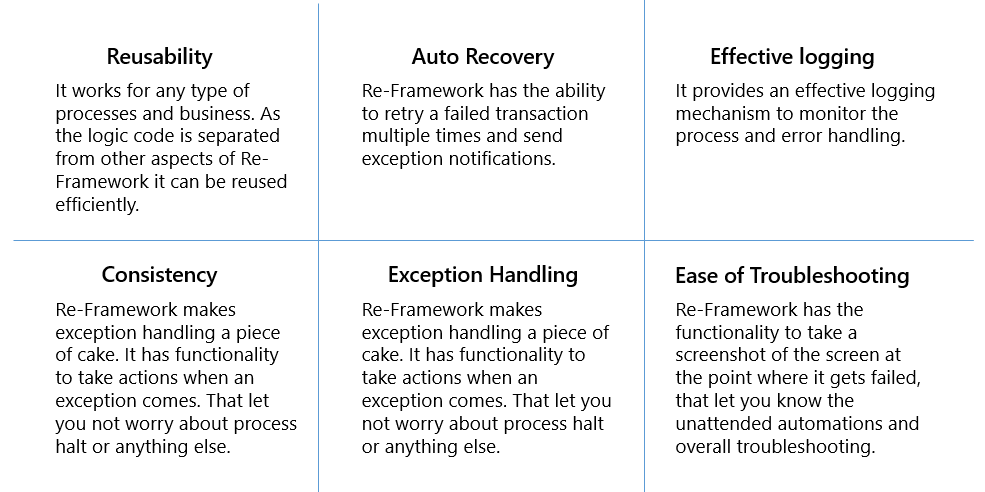
What is UiPath RE-Framework?
In short, RE framework is a template that shall help you design (automation) processes. The framework is designed to offer a way to store, read, and easily modify project configuration data, a robust exception handling scheme, event logging for all exceptions and relevant transaction information.
“RE-Framework fits all of the best practices regarding logging, exception handling, application initialization, and others, being ready to tackle a complex business scenario”.
The RE-Framework is built on top of Transactional Business Process template. It is implemented using a state machine, which is a type of workflow that has a) “States” that define actions to be taken according to the specified input and b) “Transitions” that move the execution between states depending on the outcomes of the states themselves.
Reasons to adapt RE-Framework
1. Structured approach of Development – As the project is templatized, all the automated workflows created would be consistent enough across all the developers in the team. In the long run, it will be easy to understand any developers code and the code standards will allow for a more painless handover to a different developer.
2. Maintainability – RE-Framework features built-in configuration definition, and it keeps track of configuration data by reading it from a configuration file (Config.xlsx) and stores the same in a Dictionary object (Config) during process initialization. This data is shared among the different states later and this helps in easy maintenance of projects by means of configuration, instead of modifying workflows directly.
3. Built-in logging mechanism – Most of the workflows that compose the framework use Log Message activities that output details of what is happening in each step of the execution.
4. Auto Recovery & Exception Handling – RE-Framework is designed to facilitate recovery from exceptions by either attempting to process the transaction again (i.e., retrying) or by skipping that transaction. The template is designed to work with Orchestrator Queues by default, and it can be modified easily to fit your custom needs.
5. Reusability – The framework includes pre-built reusable workflows that can be used in any of your automation. Also due to the framework structure, the business logic code you create, is always separated from the other reusable framework workflows, and this enables it to be used across multiple projects.
6. Ease in Troubleshooting – Re-Framework in many ways helps to ease your troubleshooting work by means of capturing detailed error logs. It also has built-in capability to capture a screenshot of the screen at the point where it failed, which is useful in unattended automations and overall troubleshooting.

Summary
That said, Re-Framework gives you the essence of maintainability, reusability, scalability and robustness in what it has to offer when getting started on an automation. But there are opportunities for a number of tweaks you as a developer can make, specific to the process requirements you have. That makes Re-Framework even more useful.
Alright that’s all I had to write for today. I hope to see you next time soon. Bye!
